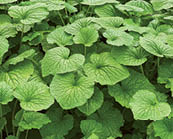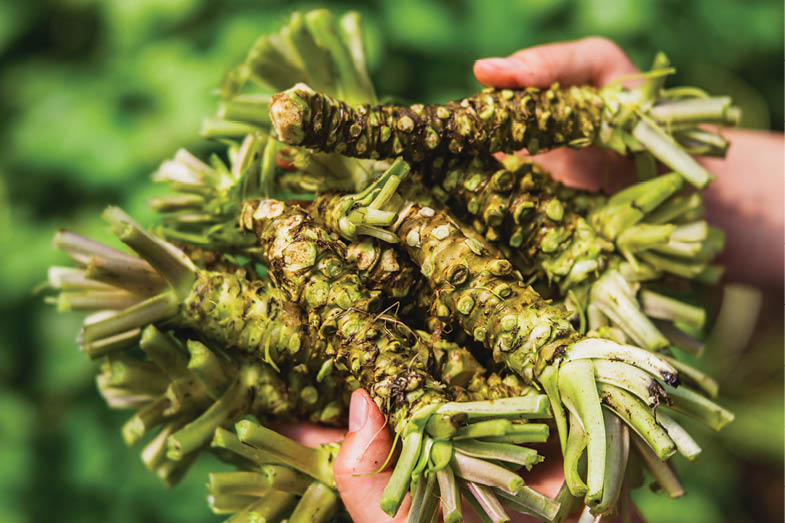Oregon-grown wasabi is a versatile and spicy option for your cooking
written by Sophia McDonald
Sushi aficionados, take note: That spicy, lime green paste next to your dragon roll may be called wasabi, but chances are it isn’t the real thing. Most of the time, it’s a combination of horseradish, powdered mustard and green food coloring.
Wasabi is native to Japan, but you can buy it closer to home than you might think. Oregon Coast Wasabi in Tillamook County is one of only three commercial growers in the United States. Co-founder and CEO Jennifer Bloeser quite by accident stumbled onto the relative of the horseradish plant at an equestrian event. A fellow participant had brought some plants to the gathering and was giving them away. Bloeser’s neighbors in Southeast Portland were always sharing the bounty from their gardens with her, and she was looking for something to give back. Wasabi, she suspected, would be an unduplicated but welcome addition to the local cornucopia.

The plant’s leaves and stalks are edible as well.
Oregon Coast Wasabi also sells seasoning salt.
Jennifer Bloeser went from a career as a marine scientist to her wasabi farm.
Bloeser and her co-founder, husband Markus Mead, went from sharing with their neighbors to distributing wasabi to a nationwide customer base in 2010. The company grows around 20,000 plants in nine greenhouses on a plot of rural land. In addition to selling fresh wasabi to local restaurants, the company offers seasoning salts, powdered wasabi and live plants to home gardeners.
Wasabi belongs to the brassica family of plants, which also includes foods such as broccoli and cabbage. Like most members, it appreciates cooler weather, which makes the Oregon Coast an ideal place to grow it. Unlike many of its cousins, though, it requires full shade, which is a primary reason Bloeser keeps the plants in greenhouses.
“It’s really fun to get to interact with the culinary world and chefs and grow something that people like to eat. People who love to garden, they get
a kick out of these plants.”
— Jennifer Bloeser, Oregon Coast Wasabi co-founder and CEO
Start to finish, it takes about eighteen months to grow a wasabi rhizome to a marketable size. Once it’s dug up and cleaned, Bloeser recommends using a microplane grater to shave small bits next to sushi or to use in various dishes.
The plant’s leaves and stalks are edible too, so it can be enjoyed long before the rhizome is harvested. “Anything you do with kale or spinach, you can do with wasabi greens,” Bloeser said. “The leaves are awesome in salads. They have a light spiciness like a mustard green or arugula. People swap them for spinach in spanakopita. They can be stir-fried or used in soup. In Japan, one of the traditional ways to eat them is to do a quick pickle. You soak them in sugar and salt, let them sit for fifteen minutes, then rinse them off.” She described the stalks as “spicy celery” and recommended juicing them.
Once the rhizome is gone, of course, the plant will be gone, too. But by that point, the plant will have produced several offshoots. Before harvesting the rhizome, break off the babies and transplant them—with the knowledge that they’re not going to take over the yard the way horseradish does.
Bloeser gave up a career as a marine scientist to become a farmer and small business owner, but has found the profession and the plants just as mentally stimulating. The company has grown so much that it’s looking to expand to a second location along the coast. It employs four people in Tillamook County.
“The plant itself is really fascinating,” she said. “It has a really deep history and a wide range of uses that, particularly in the U.S., we really aren’t aware of. They’ve been used for many thousands of years for many health-related things. It has antibacterial, anti-inflammatory and antiparasitic properties.” Evidence suggests it may have some anticarcinogenic elements as well.
“It’s really fun to get to interact with the culinary world and chefs and grow something that people like to eat,” Bloeser added. “People who love to garden, they get a kick out of these plants. It’s fun to grow something that makes people happy.”
One easy option for enjoying fresh wasabi at home is salmon crudo with kohlrabi, apple, wasabi and pickled mustard seeds from Lauro Romero, executive chef at King Tide Fish & Shell in Portland.
With the juice of fresh wasabi stalks, make a Bloody Mary mix for brunch or evening cocktails. The recipe comes courtesy of Kyle Ritchie, bar manager at Portland’s Doug Fir Lounge.
If you don’t have access to fresh wasabi, look for real wasabi powder instead. It can be used in dishes like aioli from Joe Kim, chef-owner of 5 Fusion & Sushi Bar in Bend. He likes the recipe because it’s so versatile. “It can be used to make a salad dressing. It can be used on a sandwich. It could be used to dip French fries in, or served at room temperature with asparagus,” he said.
When using wasabi powder, be sure to hydrate it first by mixing it with water or another flavored liquid, Kim noted. Skipping this step can lead to dry pockets or clumping when the wasabi is added to a dish.









